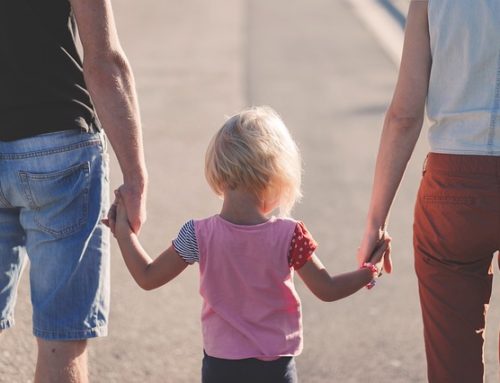When adoptions come to mind, people often think of adopting a child from the foster system. These are also called DCFS adoptions. It’s helpful to understand what happens before the adoption to better know whether this is the right path for you. Although there are children ready for adoption through the foster system now (see the end of this post for links), this is the most common path for most DCFS adoptions.
How Children come into DCFS Care & the Juvenile Court Process
Generally, the Department of Children and Family Services (DCFS) becomes involved in a family’s life because they received a hotline call alleging child abuse or neglect. An investigator will contact the family and depending on the allegations, they may feel a child is not safe remaining in the home. The DCFS worker will contact the State’s Attorney who will agree to pursue a case in Juvenile Court. In the simplest terms, DCFS is made the legal guardian of the child and the child is then placed in relative or non-relative foster care. This is just the beginning of the process.
Over the next months or years, depending on what the allegations are, the biological parents will be required to complete certain services. Often, during this period the goal is for the child to return home to the biological parents once it is considered safe. If the child is returned home, the foster parents would likely have no further involvement in the child’s life. However, if the biological parents don’t satisfactorily complete these services and returning the child home would not be safe for the child, then the State may pursue the termination of parental rights.
During the time when the juvenile court matter is pending, DCFS (or an agency contracted by them) will have the most control over where the child lives and who may eventually adopt the child, if that becomes an option. Generally, DCFS requires even relative caretakers to become licensed foster parents. During the pending juvenile court matter, the foster parent may have a lot of communication with the biological parents and may even be present for visitations between the child and their parent. This interaction with the biological parent can be one of the more complex parts of the foster adoption process. If the foster parent has a positive relationship with the biological parent, this can help both during the foster relationship and long-term with adoption, especially if the child is older and has an understanding of the situation.
If the foster placement is also a possible adoptive home, when the Petition to Terminate Parental Rights is filed by the State’s Attorney, the caseworker will confirm that the foster parent intends to adopt the child. If the foster parent does not intend to adopt the child, the agency may look for a foster placement that is open to adoption in anticipation of the termination of parental rights. It is generally at this point where the caseworker recommends that the foster parent pick an adoption attorney from the DCFS Panel, such as Family Forward Law. This panel includes only attorneys who have experience in adoptions and complete an annual training with DCFS. DCFS will pay the attorney fee and court costs for the adoption as long as the attorney used is on the panel.
The DCFS Adoption Process
Once parental rights are terminated, the caseworker will provide the adoptive parent’s attorney with a subsidy to review. This subsidy addresses the general background of the child, including any medical and mental health diagnoses, any trauma that may contribute to special needs, and what financial obligations DCFS will continue to be responsible for, including providing a medicaid card. If the child does not have special needs, the adoptive family will receive a set monthly amount currently ranging from $439-$537, based on the child’s age until the child turns 18. If the child turns 18 but has not completed high school, the adoptive parent can apply to extend the subsidy. If the child is over the age of 16 when they are adopted, the subsidy extends to age 21. If there are any concerns in the child medical history the attorney may be able to advocate that DCFS provide an increased amount or additional services outside of what is covered by Medicaid.
In some situations when adoption is not an option, long term guardianship may provide the child with a stable long-term home. Guardianship would make someone other than the biological parents and DCFS the legal guardian for the child, but would not replace the parental rights the way adoption does. In these situations, DCFS will provide a subsidy, similar to the one provided in an adoption. DCFS will also pay the attorney fee to have the subsidy reviewed if your attorney is on the DCFS panel.
In both adoptions and guardianships, only once the subsidy is negotiated, and signed by the adoptive parent, then signed by DCFS, can the actual court case be filed formalizing the relationship. Once an adoption case is filed, the agency will provide an investigative report (based on the home study they conducted) and a GAL (attorney for the child) is appointed. The family must appear in court to meet the judge for an initial presentment. Generally, the actual adoption court process can be completed in 4-8 weeks. Once the adoption is finalized, new birth certificates are issued and the family is able to move forward outside the court system. DCFS will provide post-adoption support for the years following.
Although adopting through the foster system can be a long road, there are financial benefits in addition to the benefit of providing a child who has suffered trauma with a loving, long-term home. It is important that foster parents are flexible in their timeline and understand that depending on the juvenile court process, it may be a long road. They must also understand that they may only be a temporary, but absolutely necessary, loving home for that child. The child welfare system can be complex, so it is always helpful to have resources and foster parent support from organizations such as Love Moves Us.
If you are interested in adopting a child right away, and want to adopt through the foster system, there are children waiting for adoption through Greenlight Family Services and Let It Be Us.
We’re happy to talk with you more about foster parent/DCFS adoptions and help you navigate this process as you grow your family!




